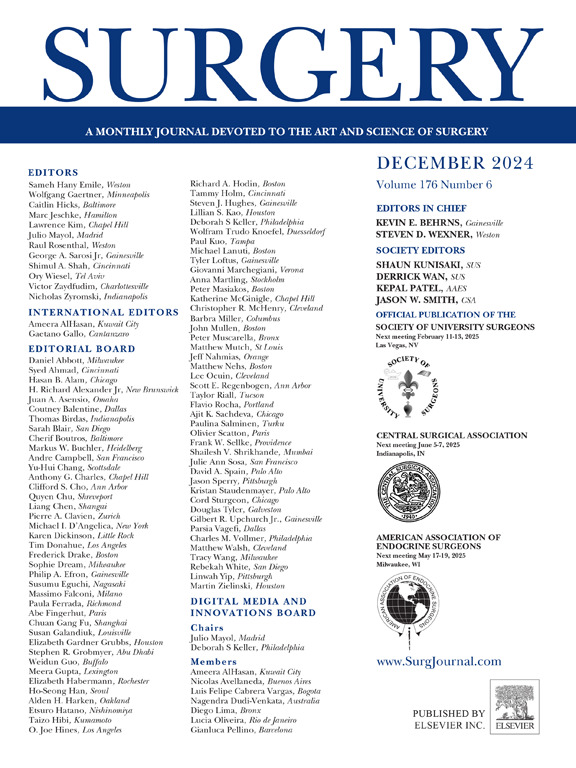枪支袭击受伤后的死亡率仍存在种族差异:创伤质量改进计划数据库的全国性分析。
IF 3.2
2区 医学
Q1 SURGERY
引用次数: 0
摘要
目标:在过去十年中,创伤护理服务的改善是否缩小了枪伤后死亡率的种族差异,目前尚不清楚:目前尚不清楚过去十年中创伤护理服务的改善是否缩小了枪伤后死亡率的种族差异:对美国外科学院创伤质量改进计划进行了查询,以了解 2008 年至 2018 年间经历过穿透性枪械攻击伤害的患者(≥18 岁)的情况。在控制人口统计学、合并症、休克指数、损伤严重程度评分损伤地点和医院特征的情况下,采用多变量逻辑回归评估死亡率与种族之间的关联:这项回顾性队列研究纳入了2008年至2018年期间因袭击而继发枪伤的261116名患者。患者最常见的身份是黑人(64.1%,n = 167,494 人),其次是白人(16.3%,n = 42,649 人)、西班牙裔/拉丁美洲裔(15.7%,n = 41,044 人)和其他种族群体(3.8%,n = 9,929 人)。在多变量逻辑回归中,黑人患者(赔率比,1.53;95% 置信区间,1.45-1.62)和西班牙裔/拉美裔患者(赔率比,1.11;95% 置信区间,1.03-1.19)比白人患者更有可能在枪支袭击受伤后死亡。与白人患者(52.7%,n = 2,838)、西班牙裔/拉美裔患者(53.0%,n = 2,635)和其他种族患者(54.8%,n = 681)相比,黑人患者更有可能死于急诊科(62.2%,n = 13,438)。在研究期间的所有年份中,黑人患者的风险调整死亡率均高于白人患者和西班牙裔/拉丁美洲裔患者:结论:枪支袭击后的死亡率仍存在显著的种族差异。急诊科内的早期死亡似乎是造成这些持续差异的重要原因。本文章由计算机程序翻译,如有差异,请以英文原文为准。
Racial disparities persist in mortality after firearm assault injuries: A national analysis of the Trauma Quality Improvement Program database
Objectives
It is unclear whether improvements in the delivery of trauma care over the last decade have diminished racial disparities in mortality after firearm injuries.
Methods
The American College of Surgeons Trauma Quality Improvement Program was queried for patients (≥18 years old) who experienced penetrating firearm assault injuries between 2008 and 2018. Multivariable logistic regression was used to assess the association between mortality and race, controlling for demographics, comorbidities, shock index, injury severity score injury location, and hospital characteristics.
Results
This retrospective cohort study included 261,116 patients who experienced firearm injuries secondary to assault between 2008 and 2018. Patients most frequently identified as Black (64.1%, n = 167,494), followed by White (16.3%, n = 42,649), Hispanic/Latino (15.7%, n = 41,044), and other racial groups (3.8%, n = 9,929). On multivariable logistic regression, Black patients (odds ratio, 1.53; 95% confidence interval, 1.45–1.62), and Hispanic/Latino patients (odds ratio, 1.11; 95% confidence interval, 1.03–1.19) were more likely to die after a firearm assault injury than White patients. Black patients were more likely to die in the emergency department (62.2%, n = 13,438) compared with White patients (52.7%, n = 2,838), Hispanic/Latino patients (53.0%, n = 2,635), and patients of other races (54.8%, n = 681). Across all years of the study period, Black patients had a greater risk-adjusted mortality rate than White patients and Hispanic/Latino patients.
Conclusion
Significant racial disparities in mortality after firearm assault continue to persist. Early death within the emergency department appears to be a significant driver of these persistent disparities.
求助全文
通过发布文献求助,成功后即可免费获取论文全文。
去求助
来源期刊

Surgery
医学-外科
CiteScore
5.40
自引率
5.30%
发文量
687
审稿时长
64 days
期刊介绍:
For 66 years, Surgery has published practical, authoritative information about procedures, clinical advances, and major trends shaping general surgery. Each issue features original scientific contributions and clinical reports. Peer-reviewed articles cover topics in oncology, trauma, gastrointestinal, vascular, and transplantation surgery. The journal also publishes papers from the meetings of its sponsoring societies, the Society of University Surgeons, the Central Surgical Association, and the American Association of Endocrine Surgeons.
 求助内容:
求助内容: 应助结果提醒方式:
应助结果提醒方式:


